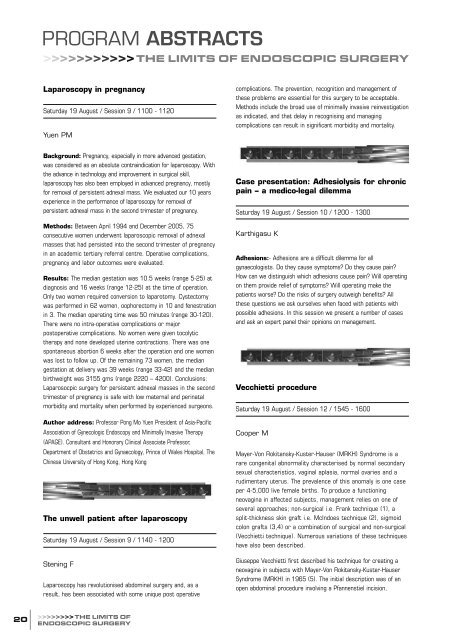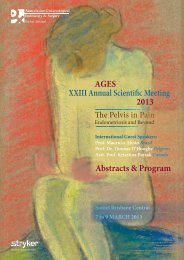ENDOSCOPIC SLIDE Flyer - AGES
ENDOSCOPIC SLIDE Flyer - AGES
ENDOSCOPIC SLIDE Flyer - AGES
You also want an ePaper? Increase the reach of your titles
YUMPU automatically turns print PDFs into web optimized ePapers that Google loves.
PROGRAM ABSTRACTS<br />
>>>>>>>>>>> THE LIMITS OF <strong>ENDOSCOPIC</strong> SURGERY<br />
Laparoscopy in pregnancy<br />
Saturday 19 August / Session 9 / 1100 - 1120<br />
Yuen PM<br />
complications. The prevention, recognition and management of<br />
these problems are essential for this surgery to be acceptable.<br />
Methods include the broad use of minimally invasive reinvestigation<br />
as indicated, and that delay in recognising and managing<br />
complications can result in significant morbidity and mortality.<br />
Background: Pregnancy, especially in more advanced gestation,<br />
was considered as an absolute contraindication for laparoscopy. With<br />
the advance in technology and improvement in surgical skill,<br />
laparoscopy has also been employed in advanced pregnancy, mostly<br />
for removal of persistent adnexal mass. We evaluated our 10 years<br />
experience in the performance of laparoscopy for removal of<br />
persistent adnexal mass in the second trimester of pregnancy.<br />
Methods: Between April 1994 and December 2005, 75<br />
consecutive women underwent laparoscopic removal of adnexal<br />
masses that had persisted into the second trimester of pregnancy<br />
in an academic tertiary referral centre. Operative complications,<br />
pregnancy and labor outcomes were evaluated.<br />
Results: The median gestation was 10.5 weeks (range 5-25) at<br />
diagnosis and 16 weeks (range 12-25) at the time of operation.<br />
Only two women required conversion to laparotomy. Cystectomy<br />
was performed in 62 women, oophorectomy in 10 and fenestration<br />
in 3. The median operating time was 50 minutes (range 30-120).<br />
There were no intra-operative complications or major<br />
postoperative complications. No women were given tocolytic<br />
therapy and none developed uterine contractions. There was one<br />
spontaneous abortion 6 weeks after the operation and one woman<br />
was lost to follow up. Of the remaining 73 women, the median<br />
gestation at delivery was 39 weeks (range 33-42) and the median<br />
birthweight was 3155 gms (range 2220 – 4200). Conclusions:<br />
Laparosocpic surgery for persistent adnexal masses in the second<br />
trimester of pregnancy is safe with low maternal and perinatal<br />
morbidity and mortality when performed by experienced surgeons.<br />
Author address: Professor Pong Mo Yuen President of Asia-Pacific<br />
Association of Gynecologic Endoscopy and Minimally Invasive Therapy<br />
(APAGE). Consultant and Honorary Clinical Associate Professor,<br />
Department of Obstetrics and Gynaecology, Prince of Wales Hospital, The<br />
Chinese University of Hong Kong, Hong Kong<br />
The unwell patient after laparoscopy<br />
Saturday 19 August / Session 9 / 1140 - 1200<br />
Stening F<br />
Laparoscopy has revolutionised abdominal surgery and, as a<br />
result, has been associated with some unique post operative<br />
Case presentation: Adhesiolysis for chronic<br />
pain – a medico-legal dilemma<br />
Saturday 19 August / Session 10 / 1200 - 1300<br />
Karthigasu K<br />
Adhesions:- Adhesions are a difficult dilemma for all<br />
gynaecologists. Do they cause symptoms Do they cause pain<br />
How can we distinguish which adhesions cause pain Will operating<br />
on them provide relief of symptoms Will operating make the<br />
patients worse Do the risks of surgery outweigh benefits All<br />
these questions we ask ourselves when faced with patients with<br />
possible adhesions. In this session we present a number of cases<br />
and ask an expert panel their opinions on management.<br />
Vecchietti procedure<br />
Saturday 19 August / Session 12 / 1545 - 1600<br />
Cooper M<br />
Mayer-Von Rokitansky-Kuster-Hauser (MRKH) Syndrome is a<br />
rare congenital abnormality characterised by normal secondary<br />
sexual characteristics, vaginal aplasia, normal ovaries and a<br />
rudimentary uterus. The prevalence of this anomaly is one case<br />
per 4-5,000 live female births. To produce a functioning<br />
neovagina in affected subjects, management relies on one of<br />
several approaches; non-surgical i.e. Frank technique (1), a<br />
split-thickness skin graft i.e. McIndoes technique (2), sigmoid<br />
colon grafts (3,4) or a combination of surgical and non-surgical<br />
(Vecchietti technique). Numerous variations of these techniques<br />
have also been described.<br />
Giuseppe Vecchietti first described his technique for creating a<br />
neovagina in subjects with Mayer-Von Rokitansky-Kuster-Hauser<br />
Syndrome (MRKH) in 1965 (5). The initial description was of an<br />
open abdominal procedure involving a Pfannenstiel incision,<br />
20<br />
>>>>>>>> THE LIMITS OF<br />
<strong>ENDOSCOPIC</strong> SURGERY

















